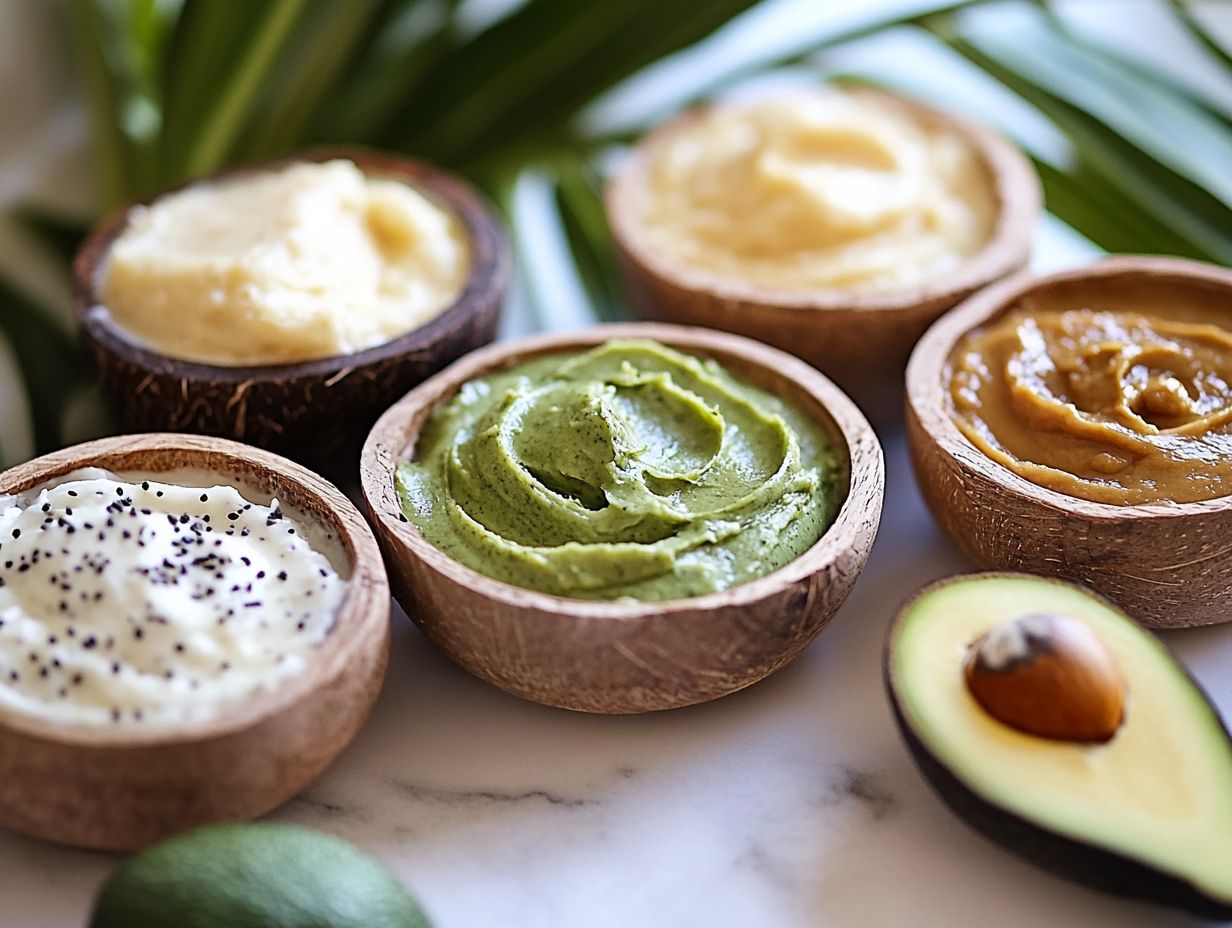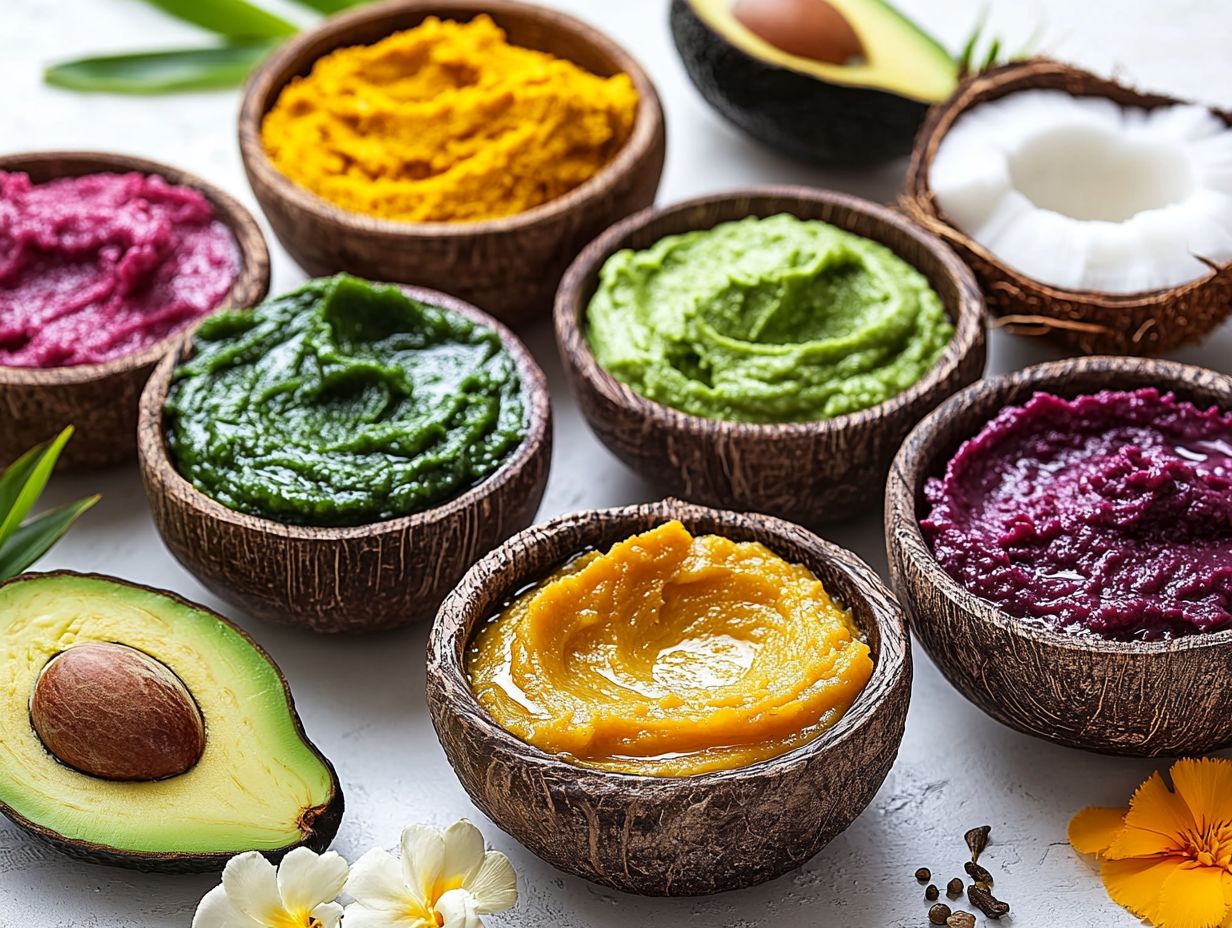Hair masks have become an essential component of beauty routines, offering the promise of transforming dull, damaged locks into vibrant, healthy hair.
But what are hair masks, and how do they function? This article delves into the various types of hair masks available, ranging from moisturizing to repairing formulas, while also examining the evidence supporting their effectiveness.
I aim to guide you in selecting the right mask tailored to your unique hair needs, weighing the benefits of DIY versus store-bought options, and providing tips for optimal application. Whether the goal is to revive your hair or maintain its health, this guide will assist you in navigating the diverse world of hair masks.
Key Takeaways:
Understanding Hair Masks

Understanding hair masks is essential for anyone committed to effective hair care routines.
I recognize that hair masks are concentrated treatments specifically designed to address a range of hair concerns, whether I aim to repair damage, enhance moisture retention, or improve overall hair health.
Experts suggest that these products can be valuable tools, particularly when tailored to my specific hair type and concerns.
With options ranging from moisturizing masks to intensive conditioners, I can see how they can significantly impact my hair’s appearance and texture. For more insights, you can check out The Science of Hair Masks: Do They Really Work?.
Regular use of hair masks can lead to silky hair and reduced frizz, making them a worthwhile addition to my hair maintenance regimen.
What Are Hair Masks and How Do They Work?
Hair masks are specialized treatments that I utilize to provide deep conditioning and targeted care for various hair types and concerns. These formulations are designed to penetrate the hair shaft, delivering hydrating ingredients that nourish and revitalize from within.
Unlike regular conditioners, hair masks offer a more intensive treatment, allowing essential nutrients to infiltrate the cortex of the hair, enhancing moisture retention and repairing damage.
I appreciate that different formulations cater to specific needs, such as dryness, frizz, or color treatment. For instance, a mask enriched with argan oil deeply hydrates and adds shine, while one containing protein can strengthen and rebuild damaged strands.
Common ingredients I look for include shea butter for moisture, coconut oil for nourishment, and keratin for structural support. This makes hair masks an essential part of a healthy hair care routine.
Types of Hair Masks
I recognize that there are various types of hair masks available, each tailored to address specific hair concerns and types, and you can learn more about them in this article on The Science of Hair Masks: Do They Really Work?.
This diversity ensures optimal results in my hair care routine.
Moisturizing Masks

I find that moisturizing masks are specifically designed to hydrate and nourish dry hair, incorporating powerful hydrating ingredients such as coconut oil, aloe vera, and honey to effectively restore moisture.
These products penetrate deep into the hair shaft, replenishing lost moisture and enhancing overall hair health. As a result, they tackle common issues like frizz, brittleness, and dullness.
When I choose a moisturizing mask, I always consider my specific hair type and any unique concerns I might have, such as whether my hair is color-treated or chemically processed.
I also appreciate DIY options, like combining avocado and olive oil, which can deliver excellent results. For those who prefer to purchase a product, brands such as Olaplex and SheaMoisture offer high-quality choices that cater to various hair needs.
Strengthening Masks
I focus on strengthening masks that enhance hair strength and resilience, often incorporating protein-rich ingredients designed to promote collagen production and fortify the hair structure.
These masks play a critical role in maintaining overall hair health, particularly for those experiencing breakage or damage due to environmental stressors or styling practices. To assess whether my hair requires strengthening, I pay attention to signs such as increased frizz, reduced elasticity, or the presence of split ends.
I find that popular products offering the necessary fortification typically contain key ingredients like keratin, which helps rebuild damaged areas, and amino acids that nourish the hair shaft.
Additionally, natural elements like honey and aloe vera enhance moisture retention, making the hair not only stronger but also more manageable.
Repairing Masks
Repairing masks are specifically designed to address hair that has been damaged by heat styling, chemical processes, or environmental factors. These products often contain intensive conditioners that work to restore vitality to the hair.
I find that these masks effectively target common issues such as split ends and frizz, providing a vital boost of hydration and nutrients that are essential for repairing and rejuvenating distressed strands. To achieve optimal results, I incorporate a repairing mask into my hair care routine once or twice a week. I recommend selecting masks that are rich in beneficial ingredients like keratin, argan oil, or shea butter; these not only help to smooth the hair cuticle but also enhance elasticity.
I apply the mask after shampooing, allowing it to sit for the recommended time to truly transform the hair’s texture, making it feel softer and more manageable. With regular use, I have seen a significant improvement in the overall health of my hair, leading to a noticeable reduction in the appearance of damage over time.
Do Hair Masks Really Work?

The efficacy of hair masks is a subject of considerable interest among hair care professionals. Numerous studies have underscored their potential benefits for enhancing both hair health and appearance.
Evidence and Studies
I have reviewed various studies that assess the impact of hair masks on hair health, and the consensus among experts is clear: they can significantly improve moisture retention and overall hair appearance.
Research suggests that hair masks often contain a combination of natural oils, proteins, and emollients specifically designed to nourish the hair shaft and repair damage.
One notable study published in the Journal of Cosmetic Science utilized a randomized controlled trial method to evaluate the efficacy of a keratin-based mask compared to a control group. The results indicated a substantial increase in hair elasticity and shine among participants who used the product regularly compared to those who did not.
Additionally, another analysis pointed out that masks containing ingredients like shea butter and argan oil effectively penetrate the hair cuticle, delivering essential nutrients that promote healthier growth.
Therefore, I believe that incorporating hair masks into a regular routine can enhance not only the aesthetics but also the structural integrity of the hair.
How to Choose the Right Hair Mask
Choosing the right hair mask involves a comprehensive understanding of my unique hair type and specific concerns. By doing so, I can select a product that effectively delivers optimal results tailored to my needs.
Factors to Consider

When selecting a hair mask, I find it essential to consider various factors, including my hair type and specific concerns, to ensure the product is effective.
For example, if I have curly or textured hair, I should seek masks rich in moisturizing ingredients like shea butter and oils. On the other hand, if my hair is fine or straight, I might prefer lighter formulations to avoid weighing my strands down.
Assessing the health of my hair—whether it’s prone to dryness, damage, or color treatment—is crucial for making an informed choice. Evaluating ingredients is also key; I look for natural oils, proteins, and vitamins that address my specific needs.
I often consider popular products like the Olaplex Hair Perfector for damaged hair or the Briogeo Don’t Despair, Repair! Deep Conditioning Mask for hydration, as they cater to varying hair types effectively.
DIY vs Store-Bought Hair Masks
When I consider hair masks, I carefully weigh the benefits of DIY options against store-bought products, as each offers unique advantages and disadvantages in hair care.
Pros and Cons
The decision to choose between DIY masks and store-bought options involves weighing various pros and cons that can significantly influence my hair care routine.
On one hand, I find that DIY hair masks offer a personal touch, allowing me to customize ingredients to fit my unique hair type and preferences. They often utilize natural, affordable materials commonly found in most kitchens, making them an accessible choice for anyone on a budget.
However, I also recognize that the effectiveness of DIY masks can vary considerably from person to person, and they may not always deliver the desired results. In contrast, store-bought hair masks are typically backed by scientific research and expert formulations, promising targeted benefits for specific hair concerns.
That said, these commercial options can come with a higher price tag and may not always be readily available in local stores. From user testimonials, it’s clear that while some individuals swear by the instant gratification of commercial options, others appreciate the nourishing qualities of homemade blends.
This illustrates the diverse preferences that exist among hair care enthusiasts, including my own experiences and preferences.
Tips for Using Hair Masks Effectively
To achieve optimal results from hair masks, I understand the importance of following specific application techniques and maintenance tips that can significantly enhance their effectiveness. For more insights, check out The Science of Hair Masks: Do They Really Work?
Application and Maintenance
The proper application and maintenance of hair masks are essential for maximizing their benefits and ensuring lasting results.
To start, I always begin with clean, dry, or slightly damp hair, depending on the specific instructions for the mask. I find it beneficial to detangle my hair beforehand, as this allows for even distribution of the product.
When applying the mask, I section my hair into manageable parts to ensure thorough saturation from roots to tips. I gently massage the product into my scalp and strands, which promotes blood circulation and enhances absorption.
After application, I often wrap my hair in a warm towel or use a shower cap to create a cozy environment. This helps lock in heat and boosts the effectiveness of the mask. To effectively incorporate hair masks into my routine, I aim for once a week or biweekly use, adjusting based on my hair type and specific needs.
Post-treatment, I focus on maintaining my hair health through regular trims, using sulfate-free shampoos, and applying leave-in conditioners. These practices contribute significantly to achieving nourished, resilient locks.


